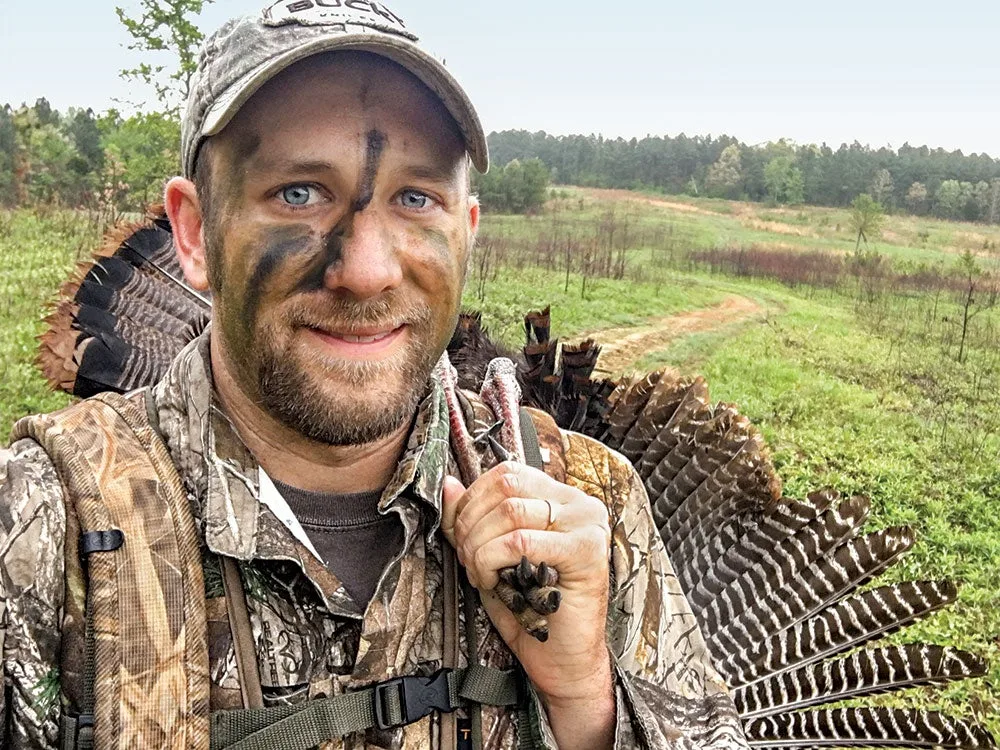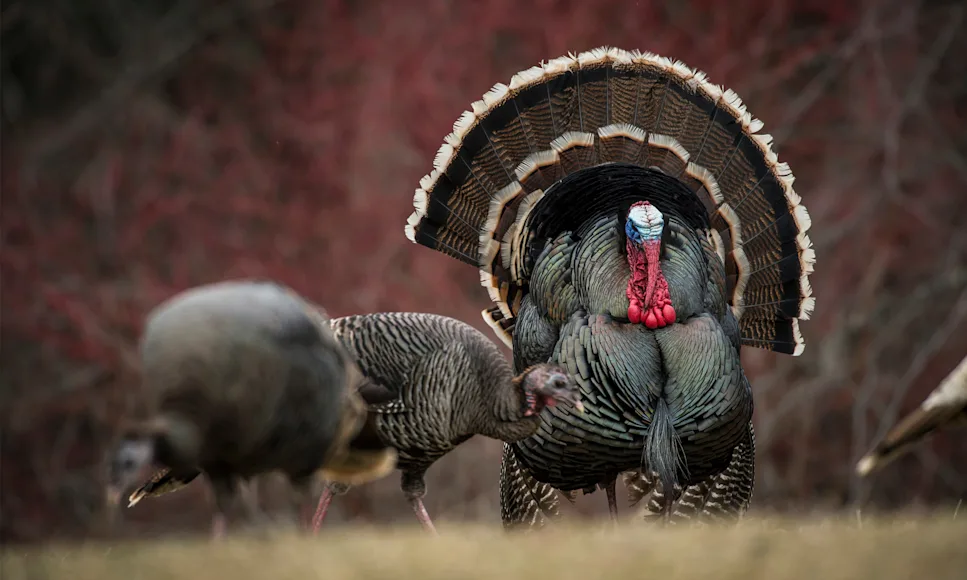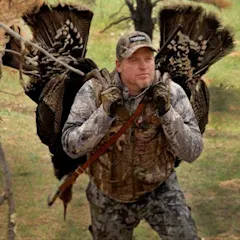With the turn of the calendar from March to April, turkey seasons in more than half a dozen states across the southern U.S. are now underway, and a slew of others are only a week or two from kicking off. Even here in the Northeast, where many of us still have a month to go, the odd 60-plus-degree day makes it feel like spring gobbler hunting is just around the bend.
Last month, we kicked off our 2025 Strut Reporters coverage by breaking down the five key phases of the turkey breeding season and asking our experts—15 of them from all around the country—to pick the key dates when turkey hunting will be at its best in your neck of the woods. We covered the pre-breeding phase in our last installment, and with flocks starting to break up in the more southern climes, it’s time to take deep dive into phase two, including what the birds are up to, how to hunt based on their behavior, and five key hunting tips from our experts.
Related: Strut Reporters: The Best Days to Hunt Turkeys This Spring
Strut Phase: Early Breeding

During the pre-breeding phase, turkeys are mostly flocked up and little actual breeding goes on. But all of that changes in the early-breeding phase. Flocks begin to break up, the first hens become available for breeding, and a noticeable shift in turkey behavior opens up opportunities for hunters.
No matter where you live, whether it’s happening this week or is still weeks away, you’ll notice the signs. You’ll get that first string of really nice spring days, everything will start greening up, you may notice that the lawn needs mowing for the first time…and suddenly, it’s like a switch is flipped. You start seeing birds in places you hadn’t before—dominant gobblers strutting in fields with packs of hens and subdominant toms and jakes venturing off on their own or in small bands, looking for company.
Those dominant toms and prime-age hens will do most of the breeding now, which results in a lot of frustrated and eager jakes and younger toms. “Buddy birds"—typically same-age gobblers and jakes—will run together, and the odds of calling in multiple gobblers on the same setup can be high. Gobbling activity remains solid, though older birds may only sound off a few times on the roost, then shut up for a time as hens run to them.
Timing of the Early Breeding Phase
As with all the other phases, when exactly this one will take place in your neck of the woods is hard to pin down. It depends on latitude, of course, but also weather. That said, as a general rule, you can expect early breeding to happen during the first week or 10 days of your season, unless your season opens unusually early (Nebraska, California) or late (Louisiana, much of the Northeast), in which case you'll need to adjust accordingly. You can use these dates as a rough guide, but the most important thing is for you to pay attention to the signs, let turkey behavior be your guide, and be ready to react.
Related: Best Turkey Guns of 2025
How to Hunt the Early Breeding Phase

Groups of hens and mixed-age males may still roost together during this period. You’ll often see them pitch down one or two at a time and slowly assemble at a field’s edge in the early morning sunshine, the toms gobbling and strutting while the jakes test one another. Sooner or later, though, 2-year-old toms and jakes are apt to split off, leaving older tom or toms with the larger group of hens.
Unless you have the perfect entry and setup, this can make the fly-down hunt tricky. A lot of times, you’re better off setting up a little off the action, being patient, and waiting for your opportunity to call in one of the strays or make a move on the dominant gobbler. Fanning, reaping, and setting up with a strutter decoy are all particularly effective during this phase, as toms that are sick of fighting later in the season are often itching for one now. Just keep in mind that these tactics and tools are banned in some places and may be frowned upon in others, depending on population numbers. Where legal, it’s your call, and we’re not going to look down our noses.
If you’re after the dominant gobbler and your scouting has shown you where he and his hens like to go after that early-morning activity—whether that’s a certainly field edge at 10am or a certain open ridge at noon—probably your best shot at him all day will be to get there early and be waiting for him.
But it’s the subdominant birds that are especially vulnerable this time of the season. They’re covering ground and looking for company. If you live in open country, take a drive with a binocular close at hand to spot roving toms. Or cover some ground yourself (carefully, remember there isn’t much foliage yet) and call aggressively. If you can strike a tom during the midmorning or afternoon now, there’s an excellent chance he, and maybe a buddy bird or two, will come running in.
Subdominant toms may roost away from the pack now, too. And if they do, you’ve got a great shot at pulling off a classic roost hunt. Get in early, get close, and your hunt may be done before the sun hits the treetops.
Related: Best Turkey Calls of 2025, Expert Tested
5 Expert Tips for Hunting the Early Breeding Phase
1. Will Brantley, Mid-South

This is a pretty good time to catch a rowdy gang of 2-year-old birds on the move. Those birds are highly susceptible to standard calling techniques, but they're brawlers, too. Figure out where they're going and be waiting for them with a jake or strutter decoy, and you'll probably get to see a good show. It's a great situation for hunting with a buddy because you can often double up. It's also ideal for bowhunters, as the birds can work themselves into such a frenzy over the decoy that getting drawn, even without a blind, can be pretty easy.
2. Steve Sherk, Northeast
During this early phase, there are lots of toms still looking for hens, and because they haven’t seen a lot of hunting pressure yet, they’re more receptive to calling. I like to run-and-gun now in the big-woods public areas I hunt. Sometimes I’ll even give up on a lukewarm bird in search for a hot one. I do a lot of calling and locating, covering a lot of ground, until I find the right tom.
3. Phillip Vanderpool, Deep South

For a roost hunt, try to get in an hour or so before daylight, because a lot of times a bird will gobble once or twice on the roost real early. That gives you an opportunity to slip inside their bubble and get set up. I like to be the first hen to call to the gobbler, and once he responds to me and I don't hear any other hens, I'm probably not going say anything else until he hits the ground. At that point, if you are in that bubble, you chances or working him in are good.
4. Jace Bauserman, Mountain West
When flocks begin to break up, you want to gain elevation and put your optics and ears to work. When you hear or see a gobbler, especially if he’s alone, move quickly to get on the same elevation or a little uphill of him. Maybe most important, don't be afraid to get loud.
5. Steve Stoltz, Midwest

Early season gobblers sound much closer than they really are. But the problem is, you don't have the cover in the woods to hide your approach. For that reason, it is paramount to get one roosted the evening before and be at that spot under the cover of darkness the next morning. This is a great period to use a jake and hen decoy combo in any field situation. Gobblers are establishing dominance and are very susceptible to a visual cue that he can see and will want to come to.


